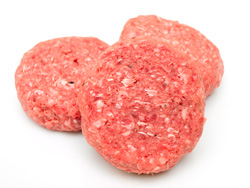Can NIR play a role in detecting horsemeat adulteration of minced beef?
Submitted by ianm on 18 February 2013 - 7:18pm
by Gerry Downey, NIR news Editor
 No-one can be unaware of the current controversy over the detection of horsemeat in minced (and generally frozen), low-cost beef products such as beefburgers, lasagne etc. Given the involvement of regulatory agencies in several European countries and the possibility of court cases after investigations have been completed, DNA analysis has been applied as a confirmatory and quantitative test in the investigations. At least one company has announced that it will routinely test incoming minced meat products for pork and horse DNA from now on. While this is the obvious analytical strategy to follow for minor contamination detection, these tests are expensive and take several days to perform so does NIR have any role to play in addressing this problem?
No-one can be unaware of the current controversy over the detection of horsemeat in minced (and generally frozen), low-cost beef products such as beefburgers, lasagne etc. Given the involvement of regulatory agencies in several European countries and the possibility of court cases after investigations have been completed, DNA analysis has been applied as a confirmatory and quantitative test in the investigations. At least one company has announced that it will routinely test incoming minced meat products for pork and horse DNA from now on. While this is the obvious analytical strategy to follow for minor contamination detection, these tests are expensive and take several days to perform so does NIR have any role to play in addressing this problem?
A quick search on any bibliographic database will show only a limited body of work in this area involving mainly binary studies to detect adulteration of minced beef by offal (doi: 10.1016/j.meatsci.2012.09.005), lamb (doi: 10.1111/j.1365-2621.1999.tb15090.x), mutton or pork (doi: 10.1021/jf9907182); some work on speciation of single species meats has also been published (doi: 10.1255/jnirs.245; doi: 10.1039/A707694K). While these studies are all sound and valid, they tend not to detect low (<1–3%) levels of adulteration and, furthermore, they do not address the main practical issue raised in the latest scandal. First, they are all laboratory studies using particular and limited meat types in a defined matrix, which generally does not include any of the other components typically found in a commercial minced meat product, e.g. cereal products used as binders, flavouring agents, other vegetable products or sauces. While some of these are usually present in relatively small amounts, some can account for a significant portion of burger weight. The effect of these extra components would need to be included in any study on beefburger adulteration by other species which would have commercial application.
A second difficulty is that most published studies have been on fresh minced meat. This sample type may work well for screening incoming raw material but is unlikely to be suitable for the analysis of cooked product; it seems likely that a separate set of models would need to be deployed in such instances. This may also be the case if the commercial component containing the undeclared species has arisen from a process which subjects the original meat to a heat-treatment step which is often the case.
Third, most of the studies reported have involved adulteration of beef by muscle from other animals—I have only been able to find one involving NIR which has studied the possibility of detecting meat offal (doi: 10.1016/j.meatsci.2012.09.005). Should it be possible this would be a real advantage, since it seems unlikely that DNA-based methods would be able to make such a distinction.
So what is the conclusion? It seems possible that, in well-defined and uncomplicated studies, NIR has the potential to detect gross adulteration of beef by horsemeat, although I have not been able to find any actual reports of such research. Whether any such capability can actually translate into practical applications is another question entirely. It seems to me that since there are a multitude of possible adulterants available to pick from, a manufacturing company would need a suite of binary models to cover all of the possibilities. So, in my view, a better way might be to develop a global model which would confirm that a minced meat mixture or processed beefburger had been formulated according to the manufacturer’s specifications; anything which was not predicted as being consistent with such a model would simply be rejected and the exact cause for non-compliance investigated subsequently. This is probably a greater challenge for NIR spectroscopy but one which is surely worthy of investigation.